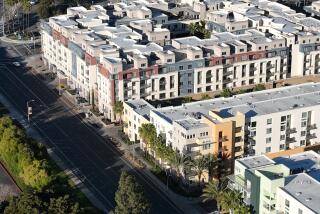S.D. Proposal : Builders Predict Home-Price Rise if Caps Approved
SAN DIEGO â Housing prices and apartment rental rates are almost certain to rise if the San Diego City Council gives final approval July 21 to an ordinance designed to sharply reduce the number of housing and apartment units built in the city, construction industry officials and economists said.
The measure, called an interim development ordinance (IDO), would impose an 8,000-unit limit per year on new permits for houses and apartments issued over an 18-month period beginning last April 29.
The IDO covers nearly the entire city with some notable exceptions, including Otay Mesa, Tierrasanta and certain transit corridors where building permits would be unrestricted.
Supply-Demand Equation Periled
That the measure would throw the marketâs supply-demand equation out of kilter and cause inevitable price inflation seemed a foregone conclusion to several industry officials interviewed last week. The unanswered questions, they say, are not whether the ordinance will force prices up, but by how much and how soon.
If final approval is given July 21 by the council as expected, the measure may take a year or more to cause a slowdown in construction. But housing analyst Sanford Goodkin with Peat Marwick/Goodkin Real Estate Consulting Group of San Diego expects the bill to have an immediate psychological impact.
âThere wonât be an obvious shortage of new housing anytime soon,â Goodkin said. âBut what cancels that out is perception. If everyone is talking about an impending shortage, that will convince people that they ought to go out and buy while they can.â
Because of the publicâs high degree of awareness of the housing market, a growth limitation bill will probably create an âacceleration of future demand to the present, causing an uptick in prices,â said Keith Johnson, chief operating officer of Fieldstone Co., a San Diego home builder.
A recently published study of growth control ordinances passed by several San Francisco Bay Area municipalities indicated that, over a four- to five-year period, there was a 20% increase in housing prices above and beyond the increase attributable to normal housing market factors, said Ken Rosen, chairman of the Center for Real Estate and Urban Economics at UC Berkeley.
âGrowth control will raise prices of houses, slow economic growth and make it less attractive for people to locate businesses (in San Diego),â Rosen said. âGrowth controls do not serve the public interest, they just raise the price of housing.â
Though conceding that the measure is likely to put pressure on prices, defenders of the measure say the adverse impact of the bill is being overblown by developers, adding that the city districts exempted from the measureâs controls may come close to making up for the reduction in other areas.
The bill fills what many proponents of the measure see as the councilâs highest priority--putting a cap on the cityâs explosive growth.
âLooking for Balanceâ
âThe council is looking for a balance between a healthy economic environment and a healthy environment, period,â City Councilman Mike Gotch said. âHousing is an important part of the economy, but the rate of growth has far outpaced our ability to provide infrastructure--sewers, schools and roads--to support it.â
Gotch said the cityâs extraordinary growth rate of 3% last year, ânearly the same as in Bangladesh,â called for extraordinary measures.
City Councilwoman Gloria McColl said an unchecked supply of housing does not necessarily make it more affordable. Despite the annual average of 15,000 housing units built in San Diego over the last two years, housing prices in the city have continued to escalate.
New houses and condos in the county sold for an average price of $136,437 in 1986, up from $123,917 in 1985 and $118,235 in 1984, according to Market Profiles of San Diego, a housing research firm.
Existing homes in the City of San Diego during 1986 sold at an average price of $145,034, up from the $130,187 average in 1985 and $123,964 in 1984, said the San Diego Board of Realtors, a group whose members broker about half of the countyâs home sales.
Dampening Effect Seen
Robert Morris, executive vice president of the Building Industry Assn. of San Diego, said growth limits and the resulting layoffs of construction workers would have a dampening effect on San Diegoâs economy because of the âmultiplier effectâ of construction jobs.
Each construction job creates 2.5 additional support jobs in insurance, retail, finance and other industries, said Max Schetter, senior vice president and director of economic research for the Greater San Diego Chamber of Commerce. âConstruction ripples through the economy,â Schetter said.
But McColl said the industryâs importance may be overstated. âThe economy is what drives construction and not the other way around,â McColl said. âI could build 1,000 houses out in the desert, but that doesnât mean people are going to flock out there.â
The IDO will have its second reading before the City Council on July 21. If the council, which approved the measure by an 8-1 vote on the first reading June 23, approves the measure, it will become law 30 days later. Each district of the city would then be given a quota of permits to be granted to developers each 90 days.
Several other county municipalities, including Oceanside, Carlsbad and Escondido, have also passed growth limits.
More to Read
Sign up for Essential California
The most important California stories and recommendations in your inbox every morning.
You may occasionally receive promotional content from the Los Angeles Times.






